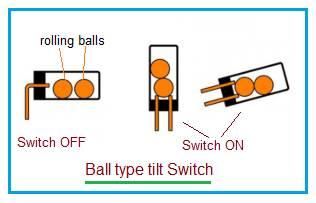Tilt Sensor Applications and Working Principles
Advertisement
A tilt sensor, also known as an inclinometer or tilt switch, is a device used to measure the tilt or inclination of an object relative to gravity. It can detect changes in orientation and is commonly used in various applications to monitor and control the position and movement of objects.
Tilt Sensor Types
The following types of Tilt Sensors are widely used:
-
Mechanical Tilt Sensors: These use a simple mechanism, such as a rolling ball or pendulum, that moves when tilted. The movement triggers a switch, providing an indication of tilt. A ball-type tilt sensor is shown in Figure 1.
-
Electrolytic Tilt Sensors: These contain a conductive liquid and electrodes. When the sensor tilts, the liquid level changes, which alters the resistance between the electrodes. This change in resistance can be measured to determine the tilt angle.
-
MEMS (Micro-Electro-Mechanical Systems) Tilt Sensors: These use micro-scale mechanical structures that change capacitance when tilted. They are commonly used in consumer electronics due to their small size and higher precision.
 Figure 1: Ball type tilt switch
Figure 1: Ball type tilt switch
Working Principle
The basic working principle of a tilt sensor involves detecting the angle of tilt based on gravity. The principle of working differs based on its type. In mechanical sensors, this could involve a ball rolling to one side and triggering a switch. In MEMS sensors, it involves measuring changes in capacitance caused by the movement of a tiny structure within the sensor.
Tilt sensors are crucial in many fields for maintaining stability, ensuring safety, and enhancing user experience by providing accurate orientation data.
Tilt Sensor Applications
Tilt sensors are widely used across various industries due to their ability to accurately measure the inclination or orientation of an object. Following are the applications of tilt sensors, including their benefits or advantages:
-
Consumer Electronics: Smartphones, tablets, laptops, and gaming controllers.
- Benefits: Enables screen rotation and motion-based controls, enhancing user interaction. Helps in image stabilization in cameras, providing clear and steady images.
-
Automotive: Vehicle stability control systems, airbag deployment systems, and tilt alarms in trucks and trailers.
- Benefits: Enhances vehicle safety by detecting rollover risks and triggering preventive measures. Provides anti-theft functionality by detecting unauthorized tilting of vehicles.
-
Industrial Equipment: Heavy machinery, cranes, and forklifts.
- Benefits: Monitors and ensures the stability of equipment during operation, reducing the risk of accidents. Helps in predictive maintenance by monitoring the tilt and wear of machinery.
-
Construction: Structural monitoring, alignment of foundations, and monitoring of heavy equipment.
- Benefits: Ensures accurate alignment and leveling of structures and equipment. Monitors tilt in real-time to prevent structural failures and accidents.
-
Aerospace: Aircraft and spacecraft attitude control and satellite orientation.
- Benefits: Provides precise orientation data, which is crucial for navigation and control. Enhances the performance and stability of aerospace vehicles.
-
Marine: Ship stability monitoring and cargo management.
- Benefits: Ensures the stability of ships, preventing capsizing and cargo shift. Helps in optimizing cargo distribution for balanced loading and enhances efficiency.
-
Medical Devices: Patient monitoring systems and prosthetics.
- Benefits: Monitors the position of patients, ensuring proper positioning for treatments and preventing bedsores. Improves the functionality and usability of prosthetic devices by providing orientation feedback.
-
Robotics: Autonomous robots, drones, and robotic arms.
- Benefits: Provides accurate tilt data, essential for precise movements and operations. Ensures the stability and balance of robots, enhancing performance and safety.
-
Agriculture: Farm machinery and monitoring of crop conditions.
- Benefits: Improves the efficiency of farming operations by ensuring proper alignment and functioning of machinery. Helps in monitoring and adjusting the tilt of machinery for optimal crop management.
Benefits of Tilt Sensors
The following points summarize the advantages or benefits of tilt sensors:
- Offers highly accurate and precise measurements.
- Offers continuous real-time monitoring of tilt.
- Many tilt sensors, especially MEMS types, are small and lightweight.
- They are versatile and hence used in wide applications.
- Consumes minimal power, making them suitable for battery-operated devices.
- Generally reliable with a long operational life.
- Affordable for many applications, especially MEMS-based sensors.
Drawbacks or Limitations of Tilt Sensors
The following are the drawbacks or limitations of tilt sensors:
- Can be affected by temperature changes, vibrations, and electromagnetic interference.
- Some tilt sensors have a limited range of tilt angles they can measure accurately.
- Integration with other systems can be complex, requiring additional components and calibration.
- Mechanical components in mechanical types may wear out over time, reducing accuracy and reliability.
- May require regular calibration to maintain accuracy.
- Some tilt sensors only measure tilt in one or two axes.
- Can produce false triggers due to sudden movements or shocks.
Conclusion
Tilt sensors play a critical role in enhancing the functionality, safety, and performance of a wide range of applications, making them indispensable in modern technology and industrial practices.
 RF
RF


